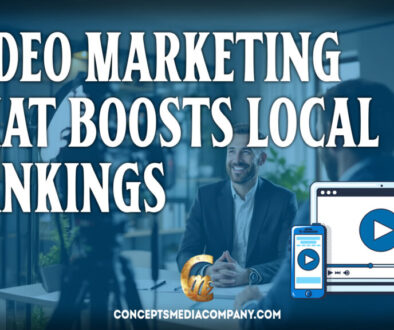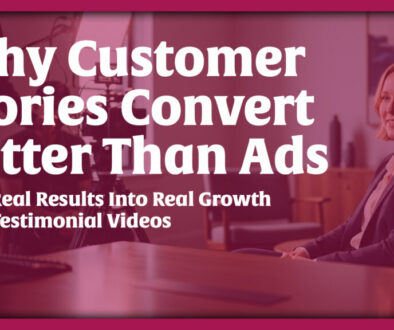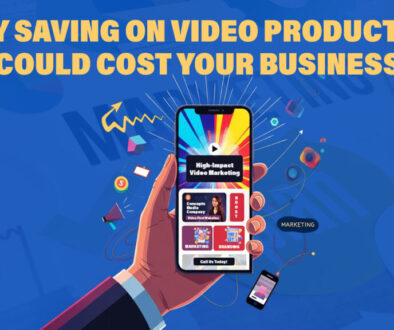2025’s Marketing Game Changer: How Video Gives You the Edge
In the digital landscape of 2025, video marketing is no longer a luxury, it’s a necessity. Online video consumption has exploded: by the end of this year, video is expected to account for over 82% of all consumer internet traffic (ap.org). Consumers are watching more video content than ever, averaging 16 hours per week according to recent studies (wordstream.com). This seismic shift towards video presents a huge opportunity for small and medium-sized businesses (SMBs) to engage their audiences in ways that text and static images simply can’t match. Below, we explore five core reasons why video marketing is essential for businesses in 2025, backed by the latest data and industry trends.
1. Video Drives Unmatched Engagement and Conversions
Video content is incredibly effective at capturing attention and driving user engagement. People tend to spend more time on websites that include video, leading to higher dwell times and lower bounce rates. In fact, 84% of marketers say that video has helped keep visitors on their website longer (wyzowl.com). This means when a visitor lands on a page with a relevant video (product demo, explainer, etc.), they are more likely to stick around and absorb the message instead of leaving immediately, a key win for engagement.
Videos also encourage users to interact and share. On social media, video posts generate 1,200% more shares than text and image posts combined (wordstream.com). Users find video more compelling and shareable, which amplifies your content’s reach organically. For example, LinkedIn reports that its users are 20× more likely to share a video post than any other type of post (vidico.com). Higher share counts translate to more eyeballs on your brand with no additional ad spend.
Crucially, all this engagement leads to tangible business outcomes. Several studies indicate that video content boosts conversions and sales. A recent consumer survey found 87% of people have been convinced to buy a product or service after watching a brand’s video (wyzowl.com). Whether it’s a testimonial that builds confidence or an explainer that answers product questions, video can directly influence purchasing decisions. It’s no surprise that 93% of marketers report a positive ROI from video marketing efforts (wyzowl.com). In short, video not only captures attention, it drives action.
2. Video Content Improves SEO and Search Visibility
Investing in video can also supercharge your search engine optimization (SEO) efforts. Search engines like Google prioritize content that engages users, and video is one of the most engaging formats available. By embedding videos on your site, you encourage visitors to spend more time on your pages. This longer dwell time sends positive signals to Google that your content is valuable, which can help boost your rankings (ap.org). In essence, a page with a relevant video is more likely to be seen as useful and authoritative, thereby standing a better chance of appearing higher in search results.
Video content also creates additional avenues for search visibility. For one, videos are highly shareable and often attract backlinks from other sites (e.g., bloggers embedding or referencing your video). Those inbound links improve your site’s authority in the eyes of search engines. According to industry research, video content is 53× more likely to generate a first-page Google ranking than plain text pages (ap.org). This outsized impact is partly due to the rich media experience videos provide and partly due to the backlink magnet effect, people are simply more inclined to link to a useful video or embed it on their own sites, boosting your SEO.
Moreover, Google now features video results prominently on Search Engine Results Pages (SERPs). It’s common to see a video thumbnail next to search listings, or a dedicated video carousel for certain queries. In fact, Google shows video thumbnails for about 26% of search results, and these listings tend to get higher click-through rates (wordstream.com). Having a video increases your chance of claiming one of those eye-catching rich snippet spots. A study by BrightEdge found that video snippets can increase organic CTR by up to 30% (ap.org), meaning more traffic driven to your site.
Don’t forget the powerhouse of YouTube for SEO. YouTube is the world’s second-largest search engine (after Google itself) (ap.org), so uploading content there dramatically widens your reach. YouTube videos often rank on Google for relevant keywords, especially how-to or tutorial content. By optimizing your video titles, descriptions, and tags on YouTube, you can capture search traffic both on YouTube and in Google’s universal search results. In summary, video marketing and SEO go hand-in-hand: videos improve user engagement metrics, provide rich snippet opportunities, and leverage the massive search volume on platforms like YouTube, all contributing to better visibility for your business.

3. The Dominance of Video on Social Media Platforms
In 2025, social media and video are virtually synonymous. Every major social platform has placed video at the center of its user experience and algorithms. Short-form videos, popularized by TikTok’s explosive growth, are now ubiquitous. Marketers report that short-form videos (TikTok, Instagram Reels, YouTube Shorts, etc.) are the most commonly used video format, with about 29% of marketers leveraging them in their strategy (blog.hubspot.com). These bite-sized clips are favored by algorithms for their high engagement: for example, YouTube Shorts content sees an industry-leading 5.9% engagement rate on average (blog.hubspot.com), and Shorts now garner over 70 billion daily views (blog.hubspot.com). TikTok, with its highly personalized feed, set the standard by drawing in well over a billion users to spend hours scrolling video after video.
Other platforms have followed suit. Instagram and Facebook (both under Meta) heavily prioritize Reels and video posts to keep users on the platform. Even LinkedIn, traditionally a text-centric professional network, has embraced video. A striking 97% of videos posted on LinkedIn are now vertical format, and 78% are recorded on smartphones (blog.hubspot.com), indicating how casual, mobile-friendly video has permeated professional content. These platforms’ algorithms tend to reward video content with greater reach. In practice, a post with video is more likely to be surfaced to your followers (and beyond) compared to a text-only update.
Importantly, both short-form and long-form videos have their place in a balanced social strategy. Short clips excel at grabbing attention and going viral, but longer videos can deliver depth and sustain interest for dedicated audiences. Marketers still rank YouTube as the #1 platform for video marketing performance (blog.hubspot.com), it’s the go-to for longer tutorials, webinars, and thought leadership content that builds authority. In fact, while most TikTok top creators focus on sub-60 second clips, data shows that TikTok videos in the 5–10 minute range (a newer capability) have started to earn the highest average views, proving there is appetite for substance alongside the snackable content (blog.hubspot.com).
From a business perspective, the domination of video on social media means you can dramatically increase your brand’s reach and engagement by using video formats. Social videos often translate directly into leads and sales. A recent report noted that 64% of consumers purchase a product after watching a branded social video (wordstream.com), underscoring the platform power of video to drive action. Additionally, live videos and streaming have risen in popularity, on Instagram, live videos have been found to deliver the highest ROI of any format for marketers (hubspot.com), and LinkedIn Live broadcasts generate massively higher engagement (some sources cite up to 24× more) than regular posts. The takeaway: whether it’s a 15-second story or a 15-minute demo, video is the currency of social media in 2025. Brands that incorporate video into Facebook, Instagram, TikTok, LinkedIn, and YouTube strategies are seeing better reach and customer interaction, while those sticking purely to static content risk falling behind.

4. Video Builds Brand Trust and Boosts Recall
Beyond raw metrics, video has a profound impact on how customers perceive and remember your brand. Trust is critical for converting prospects into customers, especially for smaller businesses competing with established players. Video can humanize your brand in ways other media cannot, by putting a face, voice, and story to your business. Whether it’s a founder’s message, a customer testimonial, or a behind-the-scenes look at your team, seeing real people on screen builds credibility and emotional connection. Viewers feel more confident when they can see and hear authenticity.
Research strongly backs the trust-building power of video. According to Wyzowl’s latest survey, 91% of consumers say that the quality of a video directly impacts their trust in a brand (wyzowl.com). A polished, informative video suggests professionalism and care, whereas a lack of video (or a poorly made one) might leave a less favorable impression. Moreover, videos help clarify product benefits and uses, reducing uncertainty. An overwhelming 96% of video marketers say video has helped increase user understanding of their product or service (wyzowl.com). When customers understand exactly what you offer and how it works, they naturally feel more comfortable doing business with you.
Video content is also memorable, far more so than text. Studies have found that viewers retain 95% of a message when they watch it on video, compared to only about 10% when reading it in text (wordstream.com). This means that your brand’s message or story, when delivered via video, is more likely to stick in the viewer’s mind. Higher recall leads to higher brand awareness and preference. It’s one reason 96% of marketers credit video for improving brand awareness in their audience (wyzowl.com). For SMBs, building brand recall is vital; you want to be top-of-mind when a customer is ready to purchase.
Finally, consider how video enables powerful forms of social proof and engagement that build trust. Customer testimonial videos, for example, let prospects hear honest feedback from people like them, adding credibility that written reviews can’t always convey. Educational videos (tips, how-tos) showcase your expertise, boosting your authority in your niche. Even something as simple as a personal thank-you video to customers or a “meet the team” series can significantly humanize your brand. It’s no wonder that 83% of consumers say they want to see more video from brands (wyzowl.com) – people crave the transparency and authenticity that video delivers. By using video to educate, tell stories, and share customer experiences, you build a foundation of trust and rapport that can set your business apart from competitors.

5. Video Production Is More Accessible (and Affordable) Than Ever
A common concern for small and mid-sized businesses is that producing quality videos will be too expensive or technically difficult. However, the landscape of video production has changed drastically in recent years. Creating professional-looking video content is now more affordable and easier than at any time in the past. The barriers to entry have lowered thanks to better technology and a wealth of creative tools.
Firstly, consider hardware: you no longer need an expensive studio setup to film high-quality footage. Modern smartphones are equipped with high-definition cameras that can shoot 1080p or even 4K video. This puts a capable video camera in virtually everyone’s pocket. Many marketers are taking advantage of this, for instance, a study of LinkedIn videos found that 78% of them were shot using smartphones (blog.hubspot.com). With a stabilizer, good lighting, and a decent microphone (all of which can be obtained cheaply), a phone is often enough to produce great content. It’s telling that 69% of video marketers say they use their own in-house equipment for production (blog.hubspot.com), rather than relying on outside studios, highlighting how common DIY video has become.
Secondly, software and editing tools have become plentiful and budget-friendly. There are free or low-cost video editing programs (like DaVinci Resolve, iMovie, Adobe Premiere Rush, and numerous mobile apps) that allow anyone to trim clips, add music, insert captions, and create polished videos without special expertise. As one marketing expert notes, you don’t need expensive software to create compelling content, what matters is good storytelling and capturing attention (blog.hubspot.com). Many popular editing tools are either free or included with devices, and even the professional-grade software has become more accessible via subscription models. Built-in smartphone apps and simple editors can handle most basic video projects (blog.hubspot.com). Additionally, we’re seeing the rise of AI-powered tools that can assist with editing (auto-generating subtitles, cuts, and even entire video drafts), which can save time and cost in the production process (blog.hubspot.com).
Finally, if producing video in-house still feels daunting, there’s a growing market of affordable video production services. Freelance videographers, creators, or local agencies are often willing to work within modest budgets, and because the demand for video is so high, prices have become competitive. According to industry data, most companies (including many small businesses) now allocate relatively small budgets to video, often under $5,000 for their video marketing efforts (blog.hubspot.com), yet they’re still able to achieve great results with that investment. The key is to start small and scale up. For example, you might begin with a few smartphone-shot customer testimonial clips or a social media Q&A livestream (virtually zero cost), and gradually expand to higher-production pieces once you see ROI. The bottom line is that cost and complexity should not hold you back from video marketing in 2025. With today’s technology, any business can create and publish quality videos that engage audiences, without breaking the bank.

Conclusion
Video marketing has become an essential pillar of digital marketing for businesses of all sizes. In 2025, consumers are watching more video, engaging more with video, and trusting video content in their purchase journey more than ever before. By leveraging video, your business can capture higher user engagement, improve its SEO presence, connect with social media audiences, build stronger brand trust, and do it all with tools that are increasingly accessible. Authoritative sources from Cisco to HubSpot to Wistia all reinforce the same point: video is a powerful medium that drives results. If you’re a small or mid-sized business owner looking to enhance your marketing, focusing on video is one of the smartest moves you can make. Start incorporating videos into your website, social channels, and email campaigns, even on a small scale, and build from there. Given the compelling data and trends, investing in video marketing now will position your business for stronger growth, customer loyalty, and competitive advantage in the years ahead. Your audience is ready to watch; it’s time to hit record and share your story.
Ready to Stand Out with Video in 2025?
Your audience is watching, are you showing up? Let Concepts Media Company help you create compelling, search-friendly videos that make your business stand out and get found faster.




